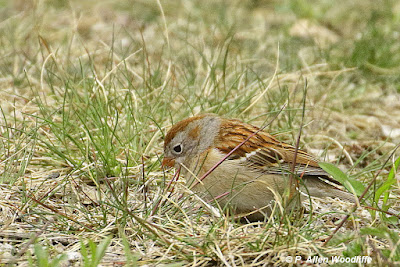It is a busy time of year. Lots of birding to do, lots of photographs to process, and lots of garden preparation to do, among other things. I've been able to squeeze a few trips out to natural areas amongst the other things, and although the bird migration has been a bit slower than birders would like (surprise, surprise), it has definitely been fun to get out.
Visits to Rondeau are always worthwhile. Warblers have been scattered and not in any great numbers, but that is bound to change soon. Many that do show up are hard to photograph against a bland sky and through branches, so more have been seen than photographed. When they are low down, I have a chance, as this Nashville Warbler and Yellow Warbler illustrate.
 |
| Getting ready for take off! |
One or more Northern Mockingbirds seem to be taking up residence at the north end of the picnic area. Maybe it will be a breeding species this year, so that will be nice to add to the Ontario Breeding Bird Atlas currently underway.
Swainson's Thrush is the most abundant of the Catharus group of thrushes these days.....
...and a few Veerys are showing up.
I have seen more Red Foxes lately, or maybe it is the same one on more than one occasion. This one decided to take a rest in a shrubby thicket, which made focusing tricky.
Eastern Chipmunks are plentiful, and occasionally will cooperate for the camera. I try and oblige.
I've spent a bit of time along the wetlands of Lake St. Clair, including at St. Clair NWA as well as the nature trails north and south of Mitchell's Bay. It has been very worthwhile. At SCNWA there are still some Ring-necked Ducks hanging around.
There were several young families out swimming around, with adults keeping a close eye on the surroundings.
What is a wetland without Red-winged Blackbirds! There are dozens and dozens.....
....and also lots of Swamp Sparrows, but they are much harder to get in front of the camera.
Occasionally one will be sitting up and trilling away, advertising its territory.
Right beside the observation tower is a broken off cottonwood, with a few holes. The top gives a good perch.
One can hear the 'witchity witchity' of the Common Yellowthroat regularly, but getting a photo as they skulk through the cattails, is another challenge.
Persistence sometimes pays off a bit.
Yellow-rumped Warblers are not confined to woodland areas. It is not uncommon to see a few in the shrubbery at the edge of the wetlands....
 |
| Birder along the SCNWA trail |
Farther north, along Angler Line and either of the Mitchell's Bay Nature Trails also gives some worthwhile viewing and photo opportunities. Bald Eagles are almost a guarantee, with typically anywhere from 3-5 seen from various vantage points...
Along the trail, you can see coyotes! But not to worry, they won't harm you. They are signs that the neighbouring farmer has put out to presumably give the local Canada Geese reason not to venture onto the field and start eating the newly planted crops. I'm not sure how effective the signs are, as I did see geese on the field, but not right close to the signs.
This Killdeer was not difficult to see at all.
A bit of a surprise was to see amongst about 30 Mute Swans, this first year Trumpeter Swan. Trumpeters are still quite a novelty in Chatham-Kent, but as the population slowly expands across southern and central Ontario, it will become a bit more common here, I expect. This one stood out with its still grayish feathering on the body and neck. It was at least as large as the nearby Mute Swans. The wide black area in front of the eye stood out...
...as did the slightly pointed feathering at the top of the beak, unlike the rounded feathering of a smaller Tundra Swan.
While I was in the Mitchell's Bay area, I got a couple of texts, first from Steve C, and a bit later from Jim B, alerting me to the presence of a White-faced Ibis that was along the Erieau Rail Trail. Jeff T had discovered it earlier that morning, and the word was put out. Instead of stopping at home in Chatham, I went as quickly as I could to get to Erieau. There were about 15 others there, and a fair number had already come and gone after having seen this rarity. It wasn't all that close to the trail by the time I got there, so a reasonable telephoto lens, and lots of cropping and processing of the digital images was required. Some folks who got there earlier had closer looks. However I shot a bunch of images, many of which were not all that great, due to the general cloudiness and back lighting, but here are a few that I kept.
It looks quite similar to Glossy Ibis, but the key differences are:
-a white band all around the eye; the Glossy does not have as extensive a white line;
-the eye is dark red, not almost black;
-the bill is gray as opposed to brown.
Under less than ideal viewing conditions, it can be a challenge to distinguish between the two species, but with 'scope views, and photos that can show the differences, it can be determined that this is indeed a White-faced Ibis, and as far as we know, only the second record for the Rondeau checklist area.
With migration underway, what will be next????
If you would like to subscribe, or unsubscribe, to Nature Nuggets, send an email to prairietramper@gmail.com
































No comments:
Post a Comment